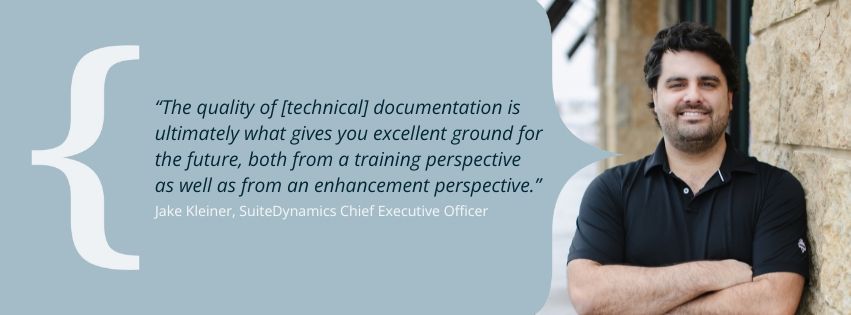Casey Watson is the Marketing Communication Specialist for SuiteDynamics. She has a degree in journalism from Murray State University and over 10 years of experience researching and writing about various subjects, including insurance, nonprofit work, and healthcare. She has been covering NetSuite ERP systems for more than two years.
Why Technical Documentation Can Make or Break a NetSuite Project
You must know what's in an ERP system to navigate or modify it. That's why you need a partner that provides thorough documentation for every customization it makes. Unfortunately, not all do that.
A NetSuite Enterprise Resource Planning (ERP) system can take significant time, money, and focus to customize and implement. After all that effort, your company will want to know precisely what functionalities and features you’ve got once developers and implementers have worked their magic.
Technical documentation shines a light on the mysteries of software development. It tells you, as a user, exactly what software experts have done to your system, how they have done it, and how you can use your new features. This NetSuite documentation helps you track a consultant’s work, and it helps future developers navigate your software.
Unfortunately, not all NetSuite partners provide detailed documentation, leaving clients disadvantaged when modifying their systems. These clients must figure out what was done to their software before they can adjust it, delaying their projects and hampering business.
We know you don’t have time to retrace a consultant’s steps whenever you want to modify your ERP platform—and you shouldn’t have to. SuiteDynamics works with NetSuite to implement and customize ERP systems, and we offer thorough technical documentation to help your company navigate the system and modify it as necessary.
This guide describes technical documentation types and why they’re essential to an ERP system’s success. Read through it and schedule a free consultation with our experts. We’ll ensure your company gets the ERP software it needs to rise in the marketplace.

What is Technical Documentation?
“Technical documentation” refers to various written materials that accompany software, ranging from user manuals and installation guides to API references and developer documentation. It offers comprehensive information about the software's functionalities, architecture, usage, and maintenance.
SuiteDynamics CEO Jake Kleiner explains that this material is critical for clients because it describes a system’s architecture and how to use its features.
Software implementers and developers must take documentation seriously, using clear, detailed language that offers the best possible picture of a NetSuite ERP instance. Otherwise, users will stumble through it without knowing how to create a report, track inventory, or perform other necessary tasks.
“The quality of the documentation is ultimately what gives you excellent ground for the future, both from a training perspective as well as from an enhancement perspective,” he explains.
At SuiteDynamics, we create four types of NetSuite documentation that encourage understanding, collaboration, and effective utilization of our software solutions.
1. Training
NetSuite is a complex system with a steep learning curve. The more help your team gets while learning the software, the faster you can maximize its potential.
Our company has prepared several tutorial documents with screenshots and step-by-step instructions describing how to accomplish tasks in the system. We can also prepare tutorials on-demand, particularly for custom solutions.
2. Business Requirements
A Business Requirement Document (BRD) is an index for your software’s construction. It lists every solution created for your system while offering a complete project overview. It details the project’s purpose and scope, user requirements (including functional and non-functional needs), and assumptions.
“Essentially, a BRD says, ‘Here's all the requirements, here's all the things we're going to do, and here's how we measure success,’" Kleiner explains.
BRDs can be charts or text, including business process maps. These maps visually represent your system’s workflows and processes, illustrating how its pieces work together.
3. Functional Requirements
This very technical document describes a single customization or solution our team has created and how we have built it. SuiteDynamics experts use FRDs to record the script used with coding processes, offering clients a detailed description of our work.
“Think of a business requirement document as a book and/or a glossary,” Kleiner explains. “And the functional requirement is like a chapter or a paragraph.”
4. Solution Design
This document type covers a solution’s scope, features, specifications, and functions, offering a thorough understanding of the software’s construction. This documentation is useful when a new development team works on the system.
If you work with SuiteDynamics, you will receive most of this documentation after your project’s discovery phase. You can use it as a guide to keep up with the project as it progresses. Schedule a free consultation with our team to learn more about how we document our processes.
Why Is NetSuite Documentation Critical for My Project?
As we’ve said, not every implementation partner prioritizes technical documentation. That’s unfortunate because the service improves the NetSuite experience in various ways.
- Enhanced Understanding: Technical documentation serves as a knowledge repository, explaining the software's inner workings, design principles, and implementation details.
- Improved Collaboration: It fosters collaboration among team members, offering a centralized source of information that reduces misunderstandings and helps everyone work toward common goals.
- Onboarding and Training: Documentation supports staff onboarding and educates users about the software. Consequently, it accelerates the learning curve and helps minimize errors.
- Support and Troubleshooting: NetSuite documentation supports troubleshooting by offering step-by-step instructions, FAQs, and tips to resolve common problems.
- Compliance and Governance: Documentation ensures compliance with industry standards, regulatory requirements, and internal policies, enhancing transparency and accountability.
SuiteDynamics ensures every project our team completes has a full list of clear, concise documents detailing the modifications we have made. We believe the more information your company has, the better you can maximize the system, and we do everything possible to set your team up for success.
Schedule your free consultation and start improving efficiency and productivity with NetSuite.
Get Everything You Need for NetSuite Success
You can’t fully navigate and use an ERP system if you don’t know what you’ve got. Without comprehensive NetSuite documentation, you’ll have to pay software experts to reverse-engineer your customization before they can modify it. You’ll waste time and money you could be using to improve the system.
We get how frustrating that situation is—especially when it’s easily avoided. SuiteDynamics offers thorough documentation on all our projects, offering guidance, clarity, and support to developers and users alike. You'll always know what we’ve done to your system and how we’ve done it.
Schedule a free consultation with SuiteDynamics experts to discuss customization or implementation or ask questions about our technical documentation process. We value frequent, clear, and detailed communication with our clients, right down to the records of our work.
Frequently Asked Questions
How often should technical documentation be updated for a NetSuite implementation?
Technical documentation should be updated whenever significant changes are made to your NetSuite instance, including customizations, workflow modifications, or after major NetSuite releases. Best practice is to establish a regular review cycle (quarterly or biannually) to ensure all documentation remains current. Outdated documentation can lead to confusion, errors, and inefficiencies as your business processes and NetSuite system evolve.
What skills should a team member responsible for maintaining NetSuite documentation possess?
The ideal documentation maintainer should have a blend of technical knowledge and communication skills. They should understand NetSuite's functionality and your specific implementation while being able to explain complex concepts in clear, accessible language. They should be detail-oriented, organized, and familiar with documentation tools and standards. Knowledge of your business processes is also valuable, as it helps them create context-relevant documentation that addresses real user needs.
SuiteDynamics experts, of course, have the knowledge and expertise to update your technical documentation properly and can do so when your company uses a Managed Services package.
What steps should we take to prepare for a documentation project if we already have an established NetSuite instance?
If you have an existing NetSuite instance without comprehensive documentation, preparation is key to a successful documentation project. Start by assembling key stakeholders who understand different aspects of your current implementation.
Conduct a system audit to identify customizations, scripts, workflows, and critical business processes that need documentation. Gather any existing materials, even if informal, such as emails, training notes, or screenshots that describe system functions. Prioritize documentation needs based on business impact and complexity.
Finally, establish clear objectives for what the completed documentation should accomplish—whether that's training new users, supporting system maintenance, or enabling future enhancements.
SuiteDynamics can guide this preparation process to ensure the documentation project captures all essential aspects of your established system.
We pull information from NetSuite material, SuiteDynamics experts, and other reliable sources to compose our blog posts and educational pieces. We ensure they are as accurate as possible at the time of writing. However, software evolves quickly, and although we work to maintain these posts, some details may fall out of date. Contact SuiteDynamics experts for the latest information on NetSuite ERP systems.
Part of this text was generated using GPT-3, OpenAI’s large-scale language-generation model. After generating the draft language, our team edited, revised, and fact-checked it to ensure readability and accuracy. SuiteDynamics is ultimately responsible for the content of this blog post.













